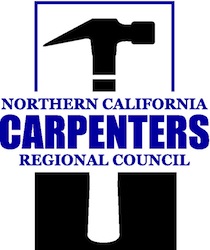It’s no secret there’s a critical housing shortage in California—half a million below-market and market-rate homes are needed right now in the Bay Area alone. Skyrocketing rents and home prices are pushing working families into two-hour commutes, students into their cars and thousands onto the streets.
At Factory OS in Vallejo, new members of Local 180 are on the cutting edge of a technology that will go a long way toward meeting these housing needs. They are building modular residential units in an assembly-line facility 20 percent cheaper and 40 percent faster than they could be built on site.
Last month, 500 union members, politicians and community leaders gathered to celebrate Factory OS’s first six months of operation. “Sure it’s new technology,” NCCRC Executive Officer Bob Alvarado told the crowd. “And we have always embraced new technology. We are going to help fulfill the American dream of home ownership.”
The Factory OS workforce, mostly recruited by NCCRC organizers, comes from all over. Daniel Flaherty and Zach Nolen were working nonunion construction. Chance Conner freelanced with his dad, remodeling kitchens and bathrooms, building fences, “whatever work we could get.” Bjorn Haro was a door-to-door salesman. Several were referred from Delancey Street, the San Francisco-based program that provides training and work opportunity for former prisoners. In short, “It’s a great opportunity for young people in our town, to have sustainable jobs,” said Vallejo Mayor Bob Sampayan.
Holliday, also the owner of Holliday Development and Factory OS Chief Operating Officer Larry Pace, owner of Cannon Construction, bring to this new venture their long experience building market-rate and below-market-rate housing. Together with an in-house architectural firm, they’ve designed an integrated, seamless workflow that creates solid, well-built residential units quickly and at a substantial savings.
WALL-TO-WALL
It’s a wall-to-wall Carpenter shop—with a three-year contract providing union wages and benefits, including company-paid health care, a retirement plan, two weeks of vacation and respect for workers’ rights. The relationship goes two ways: The union was instrumental in recruiting the workforce—at non-union worksites and by word of mouth—and helped Holliday and Pace find a facility perfectly suited to their needs. “The Carpenters have been the best partner we could have imagined,” Pace says. “I couldn’t be more proud of that relationship, and of the hard work and dedication of the men and women who work here.”
The feeling is mutual. “This is my dream job,” says Nelson Martinez, who supervises the Factory OS electrical team. Bjorn Haro adds, “It’s nice not to have to beg for a raise.” Kimberly Nettles, who spent 15 years waiting tables before Carpenters Union organizers referred her to Factory OS, agrees. “I have never
experienced anything but the greatest respect here,” she says. “The working conditions are great, there’s a real family atmosphere, and there’s a sense that we are all in this together. And I’ve never had a job with real benefits and retirement.”
ACCESS TO TRAINING
Part of Factory OS’ attractiveness to area workers is a strong culture of training. “They teach you,” says Alfonso Ramirez, a former handyman who does a little bit of everything at the plant—floors, drywall, framing, along with training new hires—“and then they really want you to move forward.” Union membership gives Factory OS employees access to classes at Carpenters Training Centers— “everything from first aid to welding and blueprint reading—the company really wants to make it possible for you to get the skills,” CTCNC apprenticeship instructor Jesus de la Torre told members at a recent union meeting. CTCNC staff are currently developing a full program specifically for Factory OS workers, he said.
CHANGE THE WORLD
Sure, Factory OS will make money, Holliday says, but there’s a mission, too: “We’ve created a system that can change the world.” The first completed project will be a homeless shelter, the second is a market-rate project, both in West Oakland. There’s plenty of work in the pipeline as well, including a contract with Google to build 300 homes next year, of which 18 percent will be below-market rate.
Factory OS certainly faces obstacles. Labor costs are higher than for the non-union competition—one-third or even 50 percent higher than for a competitive Idaho-based company. “We make up for it,” Holliday says, “by efficiency, productivity and being close to a major market. Aside from easy access to the Bay Area, we’re on the waterfront, and we can easily ship units to San Diego or Seattle.”
A tour of the factory is persuasive—a new system of air casters allows two people to move a five-ton residential unit around the floor with ease. An elaborate system of air hoses brings pressure directly to work stations. The size of the facility—two or three times as big as most modular construction facilities—allows for easy storage and expanded capacity. One modular unit takes roughly five days to work its way through the factory, and the factory can pump out at least four modular units a day.
CELEBRATING FACTORY OS WORKERS
At the celebration—billed as a tribute to the Local 180 members at Factory OS—local political and community leaders viewed the facility, inspected completed units and visited with OS workers. Among them were Assemblymembers Jim Frazier, Rob Bonta and Tim Grayson; San Mateo Mayor Rick Bonilla; Fiona Ma, who’s running for State Treasurer; and Eleni Kounalakis, candidate for Lieutenant Governor.
At that celebration, Factory OS CEO Holliday gave a nod to history: Factory OS is located in Building 680 of the old Mare Island Naval Shipyard, in the exact place where 75 years ago workers cranked out the destroyers, battleships and submarines for the Pacific fleet that had been destroyed at Pearl Harbor.
“American workers won that war,” Holliday told the crowd, “and they’re going to win this one too”.
